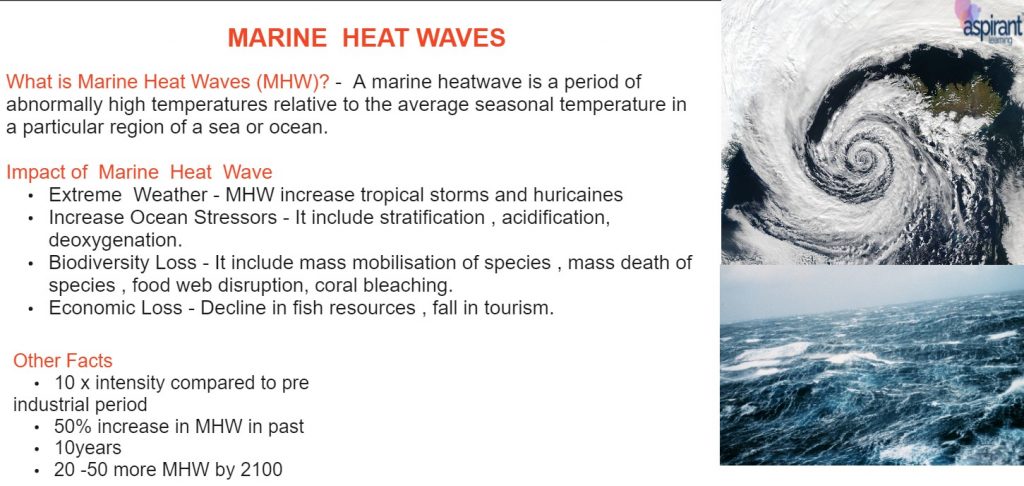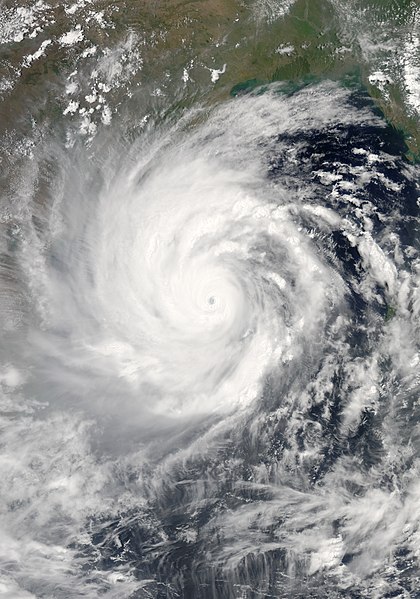News Highlights
Super cyclone Amphan boosted by marine heatwaves , studies reveal. Besides surface warming, ocean stratification and warming below the surface also played a role
What is Global Warming?
- Rising greenhouse gas emission is the primary factor for anthropogenic (human induced) climate change. The increase in carbon dioxide concentration can trap the radiation into the atmosphere and not let it go into space.
- This trapping of the extra energy increases the average surface air temperature and warms the climate that is called global warming
Global Warming and Oceans
- As the capacity of the atmosphere to absorb the heat is very less, more than 90% of the extra heat that has been trapped in the climate system has been absorbed by the oceans since 1970, according to IPCC AR5, and IPCC AR6 reports.
- Due to this, oceans are warming globally from the surface to deeper depths.
- The warming of the oceans has severe consequences such as
- Increasing intensity and frequency of extreme events
- Rising sea levels
- melting glaciers
- changing the weather pattern across the globe
Global Warming and Indian Ocean
- Studies show that due to global warming in the tropical Indian Ocean the surface water is warming faster as compared to the rest of global oceans.
- Marine Heatwaves (MHWs)
- The high sea surface temperatures are more susceptible to generating extreme temperature conditions that persist over days to months and are termed as Marine Heatwaves (MHWs).
- This intense warming of the ocean due to MHW has severe socio economic consequences such as
- Fish mortality
- Coral bleaching,
- Potential to interact and modify other extreme events such as tropical cyclones.

- The anthropogenic warming of the oceans and atmosphere facilitates the generation and intensification of extreme events such as MHWs and tropical cyclones.
- Both marine heat waves and tropical cyclones are the extreme events of the ocean atmosphere coupled system
Bay of Bengal Region and Cyclones
- The Bay of Bengal exhibits high sea surface temperatures (about 28°C) throughout the year and is more prone to tropical cyclones.
- The Bay of Bengal is home to about 57% of the total number of tropical cyclones occurring globally each year and this makes the North Indian Ocean vulnerable to the highest number of fatalities globally.
Cyclone Amphan
- Amphan was the first super cyclone in the Bay of Bengal in the last 21 years and intensified from category 1 (cyclonic storm) to category 5 (super cyclone) in less than 24 hours.
- Economic Impact
- Amphan was also the costliest tropical cyclone on record in the North Indian Ocean, with reported economic losses of approximately $14 billion in India, according to the World Meteorological Organisation and 129 casualties across India and Bangladesh
- Displacement of People
- According to the latest IPCC report (AR6), Amphan was the largest source of displacement in 2020, with 2.4 million displacements in India alone, out of which around 8,00,000 was pre emptive evacuation by the authorities.
Marine Heat Wave and Cyclone Amphan
- The presence of a strong MHW beneath the track of the cyclone with an extremely high anomalous sea surface temperature of more than 2.5°C coincided with the cyclone track and facilitated its rapid intensification in a short period.
- The Marine Heat Wave increases the lifespan of Cyclone Amphan as compared to previous one that is Cyclone Feni by 7 and 5 days respectively.
Content Source : The Hindu



